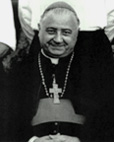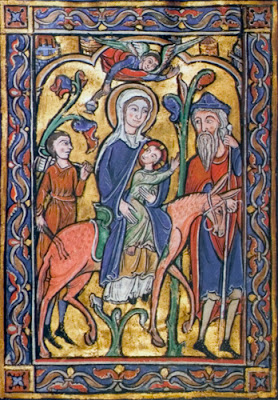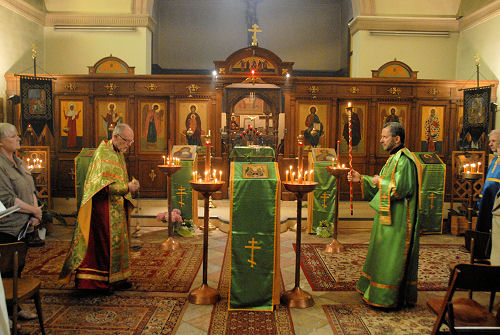Yesterday I walked through the local cathedral during my lunch hour and was awkwardly approached by a man who, had I not known better, would easily pass as Santa Claus from the film Miracle on 34th Street. He wore a large onyx crucifix around his neck and carried himself with a light demeanor. "A reflection on the faith by... uh, Cardinal Von Balthasar," he said. No sooner had I stopped to hear him than he had thrust a pamphlet into my chest and exited by the south door. The pamphlet went into my pocket for some non-devotional reading.
The only other work I have read of Hans Urs von Balthasar is his Dare We Hope That All Men Be Saved? in excerpts. It reeked of heresy on every page, not necessarily because of its conclusion, but its arrival at that point. Unlike the Alexandrian school of universalism, Balthasar's theology is so far removed from the Apostolic Fathers, the Patristic Doctors, the mystics, the Latin Schoolmen, and the Palamites that had I not known he was nominated for the red hat I would have presumed him to be a Calvinist. Every time I read him, off put by his teaching, I forget his writings' content. This layman's pamphlet, an excerpt from Balthasar's Prayer, reminded me to forget him again.
Here are some passages with my own commentary. To the best of my ability I am keeping the author's words in context.
"Thus, as in all contemplation of sin, there is a dialectic to be maintained in the contemplation of hell. We see it in the Son's being forsaken by God in his descent into the darkness of Hades. In the Son who bears, not his own sins, but mine, I glimpse into the terrible severity of the Father's judgment—for who but the Son really knows what it means to be forsaken by the Father?"This is blasphemy. It is heresy and it is blasphemy.
In three sentences this Swiss writer has divided the Godhead and made the Second Person of the Trinity into the object of God the Father's wrath. The unity of the Godhead was the focus of the first and second Councils of the Church, and it also occupied the minds and time of the great Greek and Latin Doctors of the Church. Basil the Great and Gregory the Theologian, in Hellenic fashion, began with the three divine persons and arrived at one unity, one essence called the Trinity, avoiding tritheism. In comparison, Augustine of Hippo's neo-Platonic perspective began with the one Godhead and saw the threefold personhood as the expression of God's completeness, avoiding modalism. In every sense the unity of the Father, Son and Holy Spirit was maintained and elevated as an essential part of the faith, for Christ did say "I and the Father are one" in John 10:30.
Now Hans Urs von Balthasar has divided the Father and the Son into "God" and the "Son." This language was used by the pre-Nicene Fathers as a continuation of the Jewish practice of calling the Father "God," but von Balthasar's intention seems manifestly different. The two divine persons Who share the One divine nature are divided so that the Father may "forsake" the Son, abandon him and effectively make him the object of the wrath that should be due to us. Moreover, the question "who but the Son really knows what it means to be forsaken by the Father?" should be answered with the question "who but the Son would know least what separation from the Father is?" Adam and Eve knew best, as they enjoyed an unfettered original intimacy with God devoid of the distractions of a sinful and fallen nature that cloud even those of us who hew to the Sacraments. God the Son is God before all times, begotten before time. He is part of the Beatific Vision, as St. Cyprian taught in writing "How great will your glory and happiness be, to be allowed to see God, to be honored with sharing the joy of salvation and eternal light with Christ your Lord and God." To divide the two by means one forsaking the other is an act of thought so rash not even the most vociferous Arians contemplated it.
The paragraph continues:
"All the sinner can do, contemplating the judgment pronounced upon his own sin, is simply to be there while his case is heard, to be there just as he is, the sinner who wasn't there when he was needed, who betrayed the Lord like Judas and denied him like Peter and fled like the others; he simply has to be there, involved in guilt at all points through his sinfulness, and so is bound to consent to the Judge's sentence and the Victim's cry of abandonment: Yes, that is the truth, that is what I have deserved."Balthasar elucidates his teaching later:
"The very faith and which go to make this contemplation also submit to the Father's judgment. Naturally, faith and love expect from the Father nothing but what is good; they themselves are graces flowing from the completed redemption and resurrection. But their expectation of everything that is good actually includes saying Yes to their own just condemnation. God would be right to condemn them. He was right to forsake the Son who was carrying my sin, who embodied my sin.... Yet at the same time, if my faith and love are alive and genuine, I simply cannot accept my personal condemnation from the mouth of God, for the Son, Love himself, has borne it on my behalf."In short, Christ embodied sin, so the Father forsook Him. The sinner deserves hell, but because of the sinner's "faith and love," he rejects damnation because the sin-embodying Christ has already been abandoned and condemned by the Father on our behalf.
At some level this teaching relates loosely to the early-medieval idea that our debt was so great only Christ could pay it and satisfy the Father's demand of payment. Yet, to my knowledge, the proto-Scholastics never went as far as to describe Christ as an embodiment of sin, rejected by the Father. When one reads medieval hymnody, especially Aquinas's Corpus Christi hymns, one sees no trace of the cardinal's God.
Then we sink to the depths of Balthasar's teaching:
"where a living faith and a living love are introduced to the depths of the cross, where we too experience the extinction of the resurrection light and are plunged, like Christ, into darkness. Nor is this a 'suffering with Christ,' i.e. in the company of Christ: truth requires that we suffer this divorced from him, just as Peter 'goes out' to weep in solitude his bitter tears; it does not occur to him to regard his tears as part of the Lord's redemptive suffering.... It is clear, then, that hell is to be contemplated strictly as a matter which concerns me alone."Immediately, one thinks of Matthew 16:24, wherein Jesus says "If any man will come after me, let him deny himself, take up his cross and follow me." Similarly, one thinks of John 15:5, "without me, you can do nothing." Christ's suffering makes our own suffering bearable, and even an opportunity for holiness, should we offer our sufferings and pain, our disappointments and trials to him, if we unite ourselves to the Cross. The fact that the death on the Cross was a sacrifice should illuminate our minds. A sacrifice, colloquially understood, is an act of self-emptying. In the Bible a sacrifice is a gift offered by a priest to the appeasement and praise of God, which the people would then consume; it was offered to God and yet benefited the people. Christ's death on the Cross mattered precisely because it made suffering the bridge to God, not isolation from Him. We partake of Jesus' sacrifice and suffering in Holy Communion, to our benefit. Christ in turn bids us to take up our crosses and follow Him. And are we to bear our crosses alone? We can, but in doing so, we will "do nothing."
And hell is a matter than concerns me alone? Christ's death redeemed the sins of the world and His resurrection constituted a new creation that we can join by Baptism (reading the blessing prayers for the font from the Holy Saturday liturgy). We are either in the new creation or the old, not self-determined creatures capable of enduring suffering or escaping the abyss on our own accord.
Finally, we come to the crux of the passage:
"From the standpoint of living faith, I cannot fundamentally believe in anyone's damnation but my own; as far as my neighbor is concerned, the light of resurrection can never be so obscured that I would be allowed or obliged to stop hoping for him."The first half of the sentence seemingly plays on the aphorism "We are saved together, but damned alone." The second half of the sentence, however, reveals the author's true intentions this whole time. In short, the resurrection's albescent rays shine so brilliantly on others that only I, in my sinfulness, could be damned—although I am not, because Christ was in my place. Personal guilt is replaced by divine wrath. Personal damnation is replaced by Christ's suffering. And yet, Christ's aiding strength is foregone for loneliness and feigned abandonment, in imitation of Christ's rejection by the Father, almost proximate to severance from the Godhead.
Is this not a perverse Calvinism? God hates sin, and so it is projected onto Christ, Who becomes an object of the Father's disdain so I do not? Where is Christ's love and obedience unto death? Where is the unity of the Trinity? Where is personal culpability for sin?
Take your Balthasar books and observe Reformation Day by turning them into jack-o'-lanterns.
































